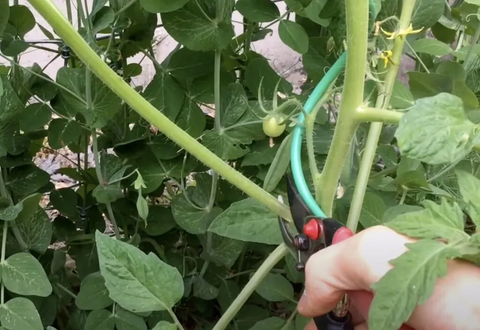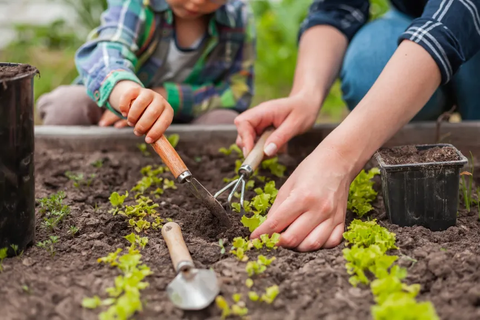Gardening is a timeless and therapeutic activity that offers numerous physical, mental, and emotional benefits. For individuals undergoing physical rehabilitation, gardening can be a particularly valuable tool in their journey to recovery. In this blog post, we'll explore how gardening can play a pivotal role in physical rehabilitation and promote healing and well-being.

The Healing Power of Gardening
Gardening has long been recognized for its therapeutic properties, and it's not surprising that it can be instrumental in the process of physical rehabilitation. Here's how gardening offers a healing touch:
1. Physical Exercise
- Strength Building: Gardening activities, such as digging, planting, and weeding, require physical effort and can aid in rebuilding muscle strength and flexibility.
- Coordination: Tasks like planting and transplanting can improve coordination and fine motor skills, which are often essential in rehabilitation.
2. Enhanced Mobility
- Balance and Stability: Engaging in gardening tasks that involve standing, walking, or squatting can help improve balance and stability, particularly beneficial for individuals recovering from injuries or surgeries.
3. Reduced Stress and Pain
- Natural Environment: The peaceful and serene environment of a garden can reduce stress and promote relaxation, which is essential for healing.
- Distraction from Pain: Engaging in gardening can be a pleasant distraction from physical discomfort or pain.
4. Mental Well-being
- Mood Improvement: Gardening is known to boost mood and reduce symptoms of depression and anxiety.
- Sense of Accomplishment: Completing tasks in the garden provides a sense of achievement and purpose, which can be particularly valuable during the rehabilitation process.
5. Sensory Stimulation
- Tactile Experience: The feel of soil, plants, and the textures in the garden can stimulate the senses, making it an engaging and sensory-rich experience.
6. Social Interaction
- Group Gardening: Participating in group gardening sessions, whether with therapists or fellow patients, can foster social connections and provide emotional support.
Gardening Tips for Physical Rehabilitation
If you or a loved one are considering gardening as a part of the rehabilitation process, here are some practical tips to ensure a safe and rewarding experience:
1. Consult with a Healthcare Professional
- Before embarking on any gardening activities, it's crucial to consult with a healthcare professional or physical therapist to ensure that the chosen activities are appropriate for your specific condition and stage of rehabilitation.
2. Plan Your Garden
- Consider the layout of your garden to minimize bending, reaching, or other movements that may strain your body. Raised beds and container gardening can be excellent choices.
3. Set Realistic Goals
- Establish achievable goals for your gardening activities. Start with simple tasks and gradually progress to more physically demanding activities as your strength and mobility improve.
4. Practice Safe Techniques
- Pay attention to proper body mechanics, such as using your legs to lift, keeping your back straight, and avoiding sudden or jerky movements.
5. Stay Hydrated and Protected
- Drink plenty of water, use sunscreen, and wear protective clothing, including a hat and gloves, to prevent sunburn and overheating.
6. Listen to Your Body
- Be attuned to your body's signals. If you experience pain or discomfort, it's essential to take a break or adjust your activity.

Incorporating Gardening into Physical Rehabilitation
Now, let's discuss how to incorporate gardening into physical rehabilitation:
1. Assessment and Safety
- Before starting, it's essential to conduct a thorough assessment to determine the individual's abilities, limitations, and any specific needs related to their rehabilitation. Safety measures, like ensuring stable footing and providing adaptive tools, should be in place.
2. Adaptive Gardening Tools
- Many gardening tools are available with ergonomic and adaptive designs, making them easier to use for individuals with physical challenges. These tools can include raised beds, lightweight watering cans, and long-handled trowels.
3. Accessible Garden Design
- Consider creating an accessible garden space that accommodates wheelchairs or mobility aids. Raised beds or container gardening can provide easier access for individuals with limited mobility.
4. Supervision and Support
- Depending on the individual's condition, they may require supervision or assistance in the garden. Caregivers or therapists can offer guidance and ensure safety.
5. Adaptive Techniques
- Teach adaptive gardening techniques that accommodate specific needs. For instance, if a person has limited hand mobility, they can use wrist cuffs or special gripping tools.
6. Progressive Gardening
- Start with simple tasks and gradually increase the complexity as the individual's physical abilities improve. This progressive approach ensures a sense of achievement and motivation
7. Mindful Gardening
- Encourage individuals to practice mindfulness while gardening. This involves being fully present in the moment, paying attention to sensations, and appreciating the beauty of the garden. Mindfulness can help reduce stress and improve mental well-being.
8. Therapeutic Plants
- Consider growing plants with therapeutic properties, such as lavender for relaxation or herbs for sensory stimulation. These plants can serve both as a practical garden element and a source of therapy.
9. Social Interaction
- Gardening can also foster social interaction, which is important for emotional recovery. Engaging with family members or a gardening group can provide a sense of community and support.
10. Recording Progress
- Encourage individuals to keep a gardening journal where they can document their progress, achievements, and the emotional benefits they experience. This can serve as a source of inspiration and reflection.
Conclusion
Gardening for physical rehabilitation is a holistic approach that combines physical exercise, sensory stimulation, and emotional healing. By incorporating gardening into the rehabilitation process and providing the necessary support and adaptive tools, individuals can experience improved physical and emotional well-being. It's an opportunity to connect with nature, set and achieve goals, and find solace in the healing power of the garden. Gardening becomes not just a hobby, but a vital part of the journey towards recovery and better health.









